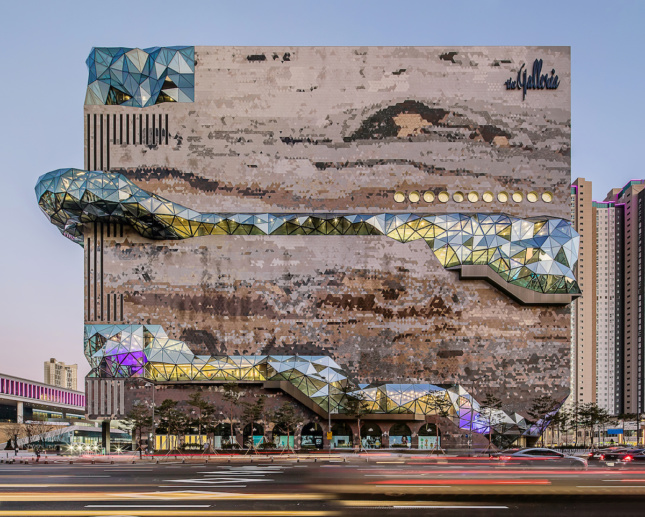Rotterdam-based Office for Metropolitan Architecture (OMA) has completed the newest outpost for upscale South Korean department store chain Galleria, in the fast-growing planned city of Gwanggyo. The Gwanggyo location, just south of Seoul, is the sixth and largest store overall for the venerable, nearly 50-year-old luxury retailer, and its first new location in a decade. Although other Galleria stores are distinctive from a design standpoint, this one takes the proverbial cake.
Set against a backdrop of residential high-rises, the building takes the form of a monolithic slab of granite with a pixilated mosaic facade that’s meant to “evoke the nature of” the neighboring Suwon Gwanggyo Lake Park, per OMA. Protruding prism-like from the hulking structure is a meandering, multifaceted glass passageway, complete with a “series of cascading terraces,” that wraps itself around the entirety of the eight-story building twice. Beginning on the ground floor and concluding at an outdoor rooftop garden, the circuitous corridor serves as a public route where well-heeled shoppers—and also the general public—can pause and take in arts- and leisure-minded activities including exhibitions and live performances.
“With a public loop deliberately designed for cultural offerings, Galleria in Gwanggyo is a place where visitors engage with architecture and culture as they shop,” said OMA partner Chris van Duijn in a statement. “They leave with a unique retail experience blended with pleasant surprises after each visit.”
At first glance, this wildly idiosyncratic department store resembles a glistening, Paul Bunyan-sized mineral stone. Some critics, however, are reminded of other things:
A good time to bury bad news – OMA unveils its new department store in South Korea, modelled on a prolapsed intestine https://t.co/5sEE4GsPb4 pic.twitter.com/nE8MAoohwg
— Olly Wainwright (@ollywainwright) March 25, 2020
In total, the rubberneck-inducing department store, which OMA envisioned as a “a natural point of gravity for public life in Gwanggyo,” encompasses roughly 1.6 million square feet including a sizable, multi-level subterranean space complete with a market hall. The building’s upper floors are home to a movie theater, lounges, restaurants, and other amenities.
According to the English-language daily The Korea Times, the Gwanggyo branch of Galleria was slated to open to the public in late February but was delayed to concerns over the novel coronavirus (COVID-19) outbreak. Galleria, which is akin to Neiman Marcus or Nordstrom but perhaps a touch ritzier at some locations, is owned by South Korean mega-conglomerate Hanwha.
